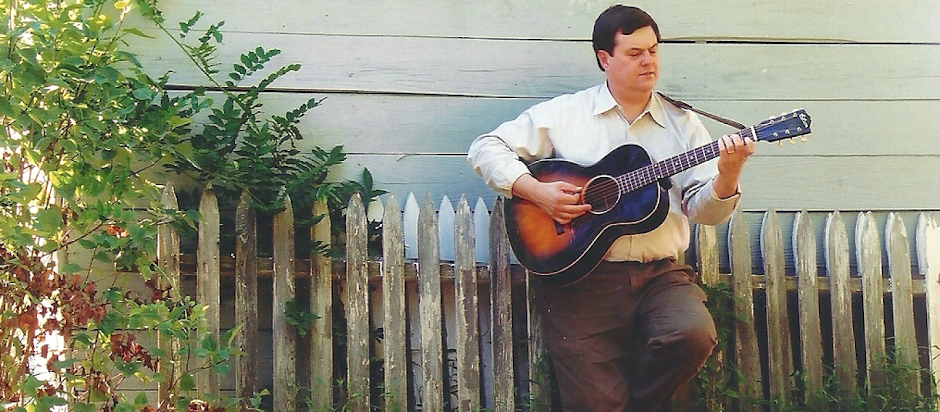No. 3 — Summer 2006
Mementos incite magic at Vintage Concerts
Displaying and playing guitars with known provenance, or ownership record, has added an exciting element to many Vintage Music Concerts. Recounting an instrument's provenance authenticates the vintage appeal of a program for an audience even as it enhances the musical offerings and anecdotes by Ken Lelen. As of Summer 2006 the instruments with provenance in my collection include:
1938 Gibson GS-35 — the Ross Hitch classical
1938 Gibson GS-35 — the Ross Hitch classical
One of 39 ever made, this mahogany-bodied classical guitar was purchased nearly new in 1939 at a Toronto pawn shop by Ross Hitch (1919 - 1945), a full-time professional musician and arranger, as well as part-time guitar teacher. Hitch played the Gibson classical only a short while before an untimely death at age 26.
"He loved guitars and classical music, but playing trombone was a lucrative job in his day — the Big Band Era," said Hitch's daughter, Mary Blendick of Stratford, Ontario.
Today the guitar is in pristine condition due to the fact that it sat in a corner of the family dining room — virtually unplayed — for more than 60 years, said Blendick.
1951 Epiphone Triumph Regent — the Gordy Burgess archtop
"He loved guitars and classical music, but playing trombone was a lucrative job in his day — the Big Band Era," said Hitch's daughter, Mary Blendick of Stratford, Ontario.
Today the guitar is in pristine condition due to the fact that it sat in a corner of the family dining room — virtually unplayed — for more than 60 years, said Blendick.
1951 Epiphone Triumph Regent — the Gordy Burgess archtop
This is a maple-bodied archtop guitar, played for 50 years by John Gordon (Gordy) Burgess (1915 - 2005) of Chicago, IL and Altamount Springs, FL. He played jazz-style guitar as well as harmonica throughout his life, according to his wife, Ginny Burgess of Orlando, FL.
1955 Martin 0-18 — the Ken Eskew guitar
1955 Martin 0-18 — the Ken Eskew guitar
This guitar was played for 40 years by Kenneth Eskew (1918-2001) of Greenville, SC. An aerospace engineer, Eskew mostly played the guitar to relax, said his wife, Marion Eskew. "Some days he'd come home and rush into the bedroom to play his guitar for a while before he could even talk to anybody."
1937 Kalamazoo KG-21 — the Floyd Riggs archtop
1937 Kalamazoo KG-21 — the Floyd Riggs archtop
This budget-priced, archtop is one of 14 instruments found in the estate of Floyd Riggs (1923 - 2001), who paid $21 for this Gibson-made, budget-priced instrument in 1937. After a stint in the U.S. Army during WW II, Riggs returned home to Vienna, WV.
He was employed for 30 years in the purchasing department of a large chemical firm near Vienna, an Ohio River town that today is surrounded by tract homes and suburban traffic. Back in the day Riggs liked to play his guitars and mandolins at night and on weekends for local jamborees or social events. He loved to play his instruments — but not sing, friends of the family recalled.
1950 Silvertone — the Marie Williams guitar
He was employed for 30 years in the purchasing department of a large chemical firm near Vienna, an Ohio River town that today is surrounded by tract homes and suburban traffic. Back in the day Riggs liked to play his guitars and mandolins at night and on weekends for local jamborees or social events. He loved to play his instruments — but not sing, friends of the family recalled.
1950 Silvertone — the Marie Williams guitar
This is an inexpensive, birch-bodied guitar built by Harmony of Chicago and sold at Sears, Roebuck. It was played for decades by Marie Williams, a middle-school biology teacher, retired and residing in Orlando, FL.
1940 Gibson A-50 — the Ernst Koch mandolin
This mandolin was played for 60 years by Ernst Koch (1906 - 2001), a language teacher and WWII veteran. He began playing mandolin in 1916, paying $9 for a bowl-back mandolin and 75 cents for twice-weekly lessons from a musician named Professor Moscati, a clerk in his father's woolen shop in Clifton, NJ. As a teenager Koch performed in a 50-piece mandolin orchestra that practiced above an Italian saloon. He also played banjo-mandolin, saxophone and clarinet. "I bought the A-50 directly from Gibson, which mailed it to me," Koch said four months before he passed away. "I loved to play that mandolin. I found it a great emotional outlet."
1940 Gibson A-50 — the Ernst Koch mandolin
This mandolin was played for 60 years by Ernst Koch (1906 - 2001), a language teacher and WWII veteran. He began playing mandolin in 1916, paying $9 for a bowl-back mandolin and 75 cents for twice-weekly lessons from a musician named Professor Moscati, a clerk in his father's woolen shop in Clifton, NJ. As a teenager Koch performed in a 50-piece mandolin orchestra that practiced above an Italian saloon. He also played banjo-mandolin, saxophone and clarinet. "I bought the A-50 directly from Gibson, which mailed it to me," Koch said four months before he passed away. "I loved to play that mandolin. I found it a great emotional outlet."
________________________________________________________
Vintage sheet music collection grows with recent gifts
 |
| Fred and Ginger, 1935 |
• Bob and Isabelle Doty of Rock Hill, SC;
• Edna Adams of Northampton, MA;
• Gladys Dean of Philadelphia, PA;
• Mary Sampson of Advance, NC;
• Jeanne Rudy of Advance, NC;
• Ann North of West Chester PA;
• Edna and Mert Couture of Holyoke MA;
• Estelle Kay of Holden, MA;
• Gladys Laird of Feasterville, PA;
• Isabelle Mann of Orlando, FL.
_________________________________________________________
© 2006 Ken Lelen - All Rights Reserved



No comments:
Post a Comment